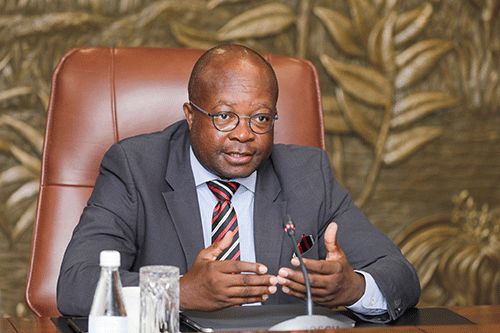National Planning Commission director general Obeth Kandjoze, who is also Namibia’s green hydrogen (GH) council chairperson, has made it clear the GH project is an executive project. Thus, he said, the executive took it upon itself to race this project through to bring it to fruition.
Kandjoze made these remarks on Wednesday during a televised interview on the Namibia Broadcasting Corporation (NBC). The engagement was aimed at clarifying the council’s work after Landless People’s Movement (LPM) parliamentarian Henny Seibeb tabled a motion in the National Assembly noting concerns about the project pace and the lack of parliamentary consultation.
“You have the executive, legislator, and the judiciary. This is an executive project, so the executive did some significant amount of public engagements but not as wide as we could, that we should admit. We still are going to go back to the public. So, from ground zero where we started, and in 18 months, we have a phenomenal agreement. In my mind, we started from almost nothing. Rome was not built in a day, just like green hydrogen would not be built in a day,” said Kandjoze.
He added that Namibia has commitment and political will to make the project a reality.
Meanwhile, Seibeb in his motion questioned how the GH council expects to introduce a synthetic fuel bill and to promulgate the legislation when parliamentarians, specifically relevant clusters on economic affairs and natural resources, have not been properly engaged or informed.
“Our understanding is that the feasibility and implementation agreement (FIA) states that the government may be held liable if the legislative frameworks are not in place that can hinder Hyphen operations. To always avoid committing errors, learn to discuss all national programmes and initiatives in parliament. It is a national priority that demands lawmakers to craft a mutually beneficial scenario for the deployment of clean hydrogen as a thriving industry,” Seibeb urged.
The concerned MP further questioned whether GH is “a padlock to poverty or a key to prosperity”. He said efforts of trying to ensure the project delivers positive results, signals the right path, but noted it is still not durable and does not provide a firm commitment to driving the project beyond 2025.
According to Seibeb it is imperative to critically assess the pace and scale of government efforts to ensure Namibia is not just pursuing individual projects, but is surely building a sustainable and thriving green hydrogen industry that can drive the nation’s energy transition and economic growth in a meaningful and impactful way for the foreseeable future.
Seibeb further implored all members of parliament and the executive to re-evaluate the approach to this transformative opportunity that has the potential to positively impact the lives of many.
“The stakes are high as we risk falling behind other nations, both on the continent and beyond that are making rapid progress in the green hydrogen sector. Is important to emphasise that we cannot build a sustainable industry if we continue with the same approach we have taken with Hyphen Hydrogen Energy. It has already taken the government two long years of negotiations,” the deputy LPM leader explained.
Meanwhile, at last month’s signing ceremony between the Namibian government and Hyphen for the FIA of the billion-dollar green hydrogen project, President Hage Geingob urged Namibians to support government efforts, emphasising that opposition to national projects may hinder much-needed developmental progress.
He said the project holds tremendous potential to entirely transform the domestic economy.
The agreement gave Hyphen Energy the go-ahead to govern the development, implementation, and operation of sub-Saharan Africa’s largest and only fully vertically integrated green hydrogen project.
Hyphen Hydrogen Energy is a joint venture between Nicholas Holdings and Enertrag South Africa. As the preferred bidder, Hyphen was selected for a 40-year deal to develop Namibia’s US$10 billion green hydrogen project in the Tsau //Khaeb National Park.
The partnership represents the first step in Namibia’s journey to unlocking the potential of becoming one of the world’s leading green hydrogen production hubs by leveraging the country’s world-leading wind and solar resources, vast open spaces, and stable investment climate, underpinned by strong democratic values.
Caption:


